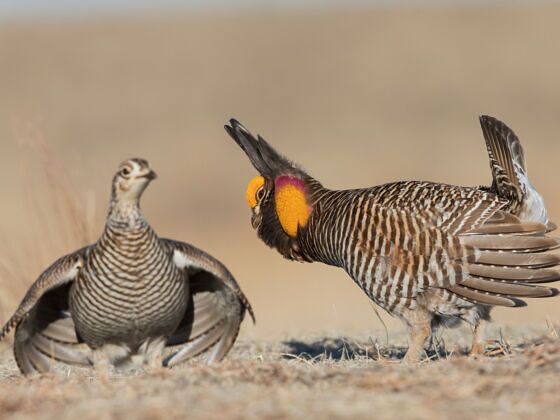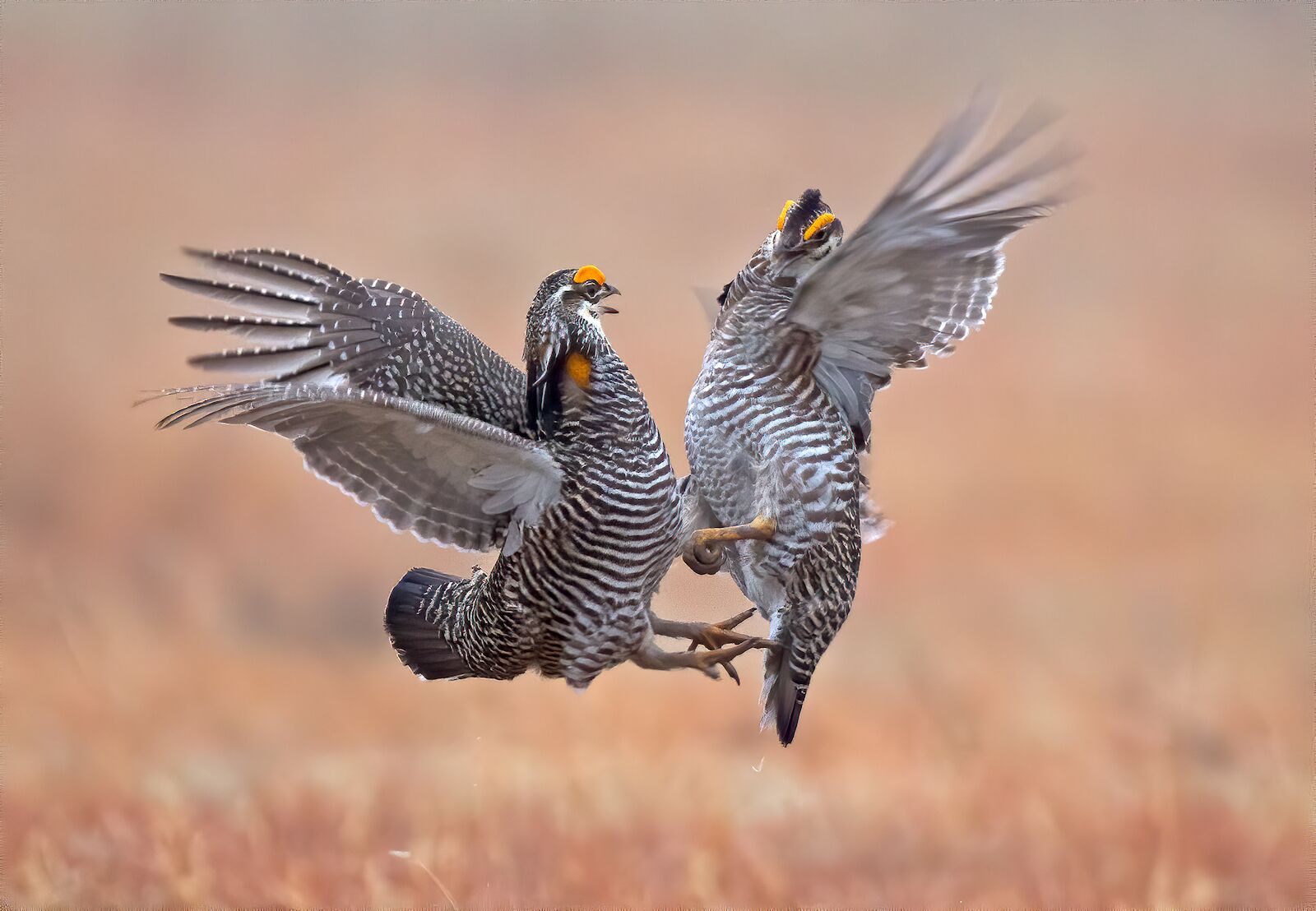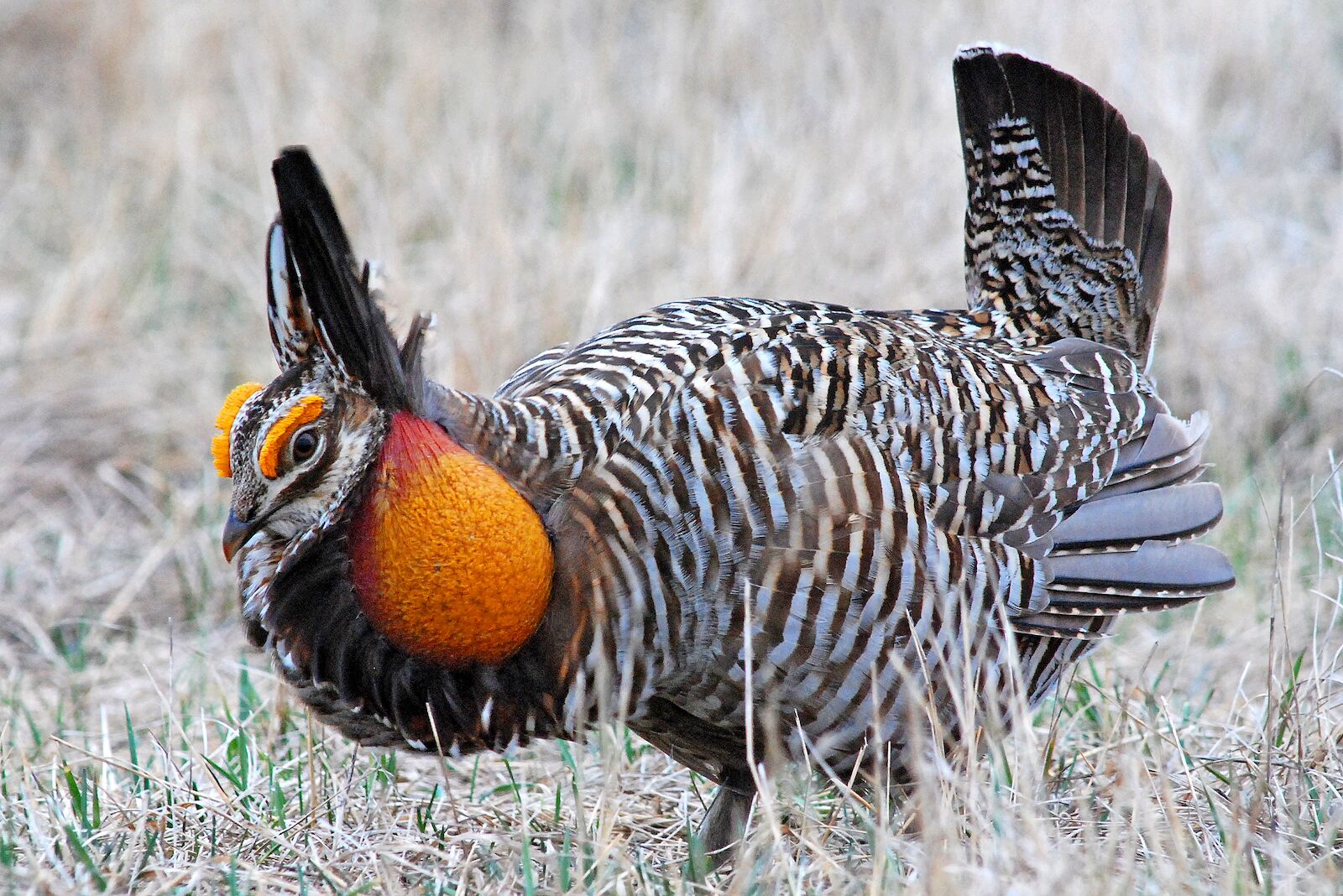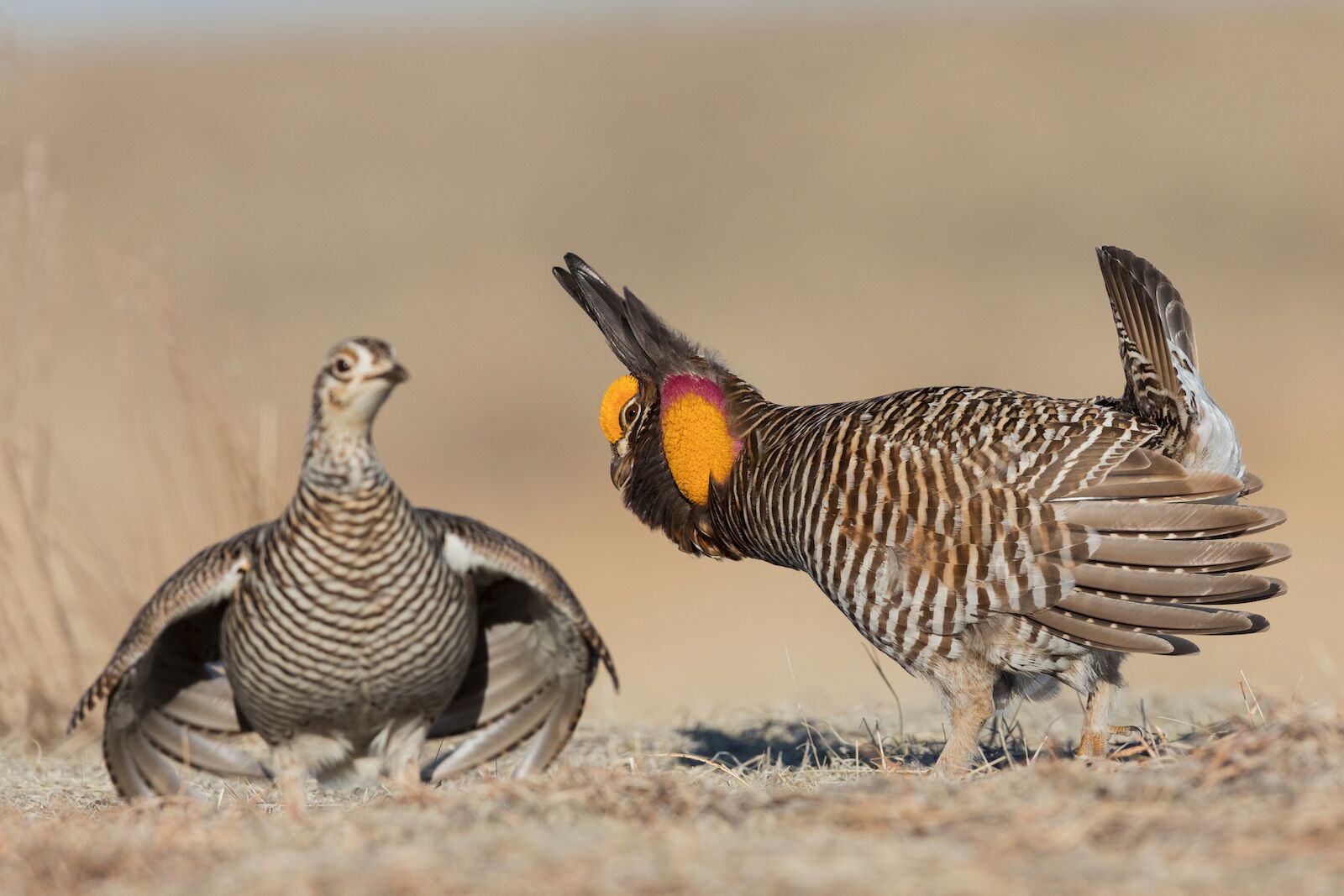It was a rough morning at Club Lek for Mortimer the prairie chicken. He’d arrived long before sunrise, scoping out the best spot in the club before the females arrived. He busted out his best dance moves, hopping around in semi-circles, whooping, and fast-stepping across the floor. When the sun came up, the ladies were treated to a brilliant display of his bright orange plume, exploding out from under his neck.


'Shape-Shifting Demon Chickens:' How to See One of the US's Weirdest Birds
But as soon as Mortimer began showing off, a bigger prairie chicken challenged him to a fight, and took over Mortimer’s prime real estate.
Since it was cold outside, and most of the ladies had stayed home to protect their chicks, he was left with few options. He slinked back into the corner of Club Lek with a couple of other out-of-luck prairie chickens, likely realizing his chances of copulation were pretty slim. He let out another whoop, perhaps meaning “this place is dead, anyways.” As the sun began to creep up on the sprawling Colorado plains, Mortimer and his friends hopped their way out, bidding farewell to another fruitless morning.

Photo: Rob Palmer Photography/Shutterstock
But unlike a human who strikes out after a night at the club, Mortimer had an entire gallery of people watching his failure.
Such is an average morning at the prairie chicken breeding grounds during mating season in Wray, Colorado. It’s a bucket-list experience for many birders, and the biggest tourist attraction in the flatlands of eastern Colorado. The name may sound a little silly, and it might not offer the same high-speed thrills as you’ll find in the western part of the state on skis or a mountain bike. But if you’re the kind of traveler who seeks unique travel experiences you’ll barely find on Instagram – or are an avid birder – it’s an ideal way to explore a corner of the country few people ever visit.
What the heck is a prairie chicken?

Photo: Brian A. Wolf/Shutterstock
The greater prairie chicken is actually not a chicken, but rather, a member of the grouse family more closely related to pheasant or quail. The plucky little birds scuttle their way around the Great Plains region of the United States, most of them living somewhere between North Dakota and northern Oklahoma, but also dipping into Colorado and Missouri. Like a lot of midwestern grassland animals, their numbers fell to near-extinction in the 20th century when farmers converted their habitat into agricultural land.
But the species has made a slight comeback and is now only rated as a threatened species. But because only a few hundred thousand exist across near-limitlessness of the Great Plains states, their unusual mating show is hard to witness. When they’re on the prowl, they inflate huge sacks on their necks and turn their head feathers straight up, looking like ears or horns. One Redditor called it “a shape-shifting demon chicken,” while another said,”Cute tho. Looks like a bunny and a chicken made a baby.”
“If you’re a birder, it provides one of the most unique combinations of audio and dance and plumage you’ll find,” says Ardith Hendrix, Director of the Wray Museum in Wray, Colorado, who runs eight tours a year during the March and early April mating season. “Usually, you see beautiful plumage with no sounds, or you see a bird just known for its sounds. The greater prairie chicken combines them both.”

Photo: Danita Delimont/Shutterstock
There are a number of places you can do these tours, but Wray is the easiest and most organized setting. It’s also convenient, at less than two hours from the Denver airport, and arguably the most scenic.
Wray itself is the kind of place you fly over on an airplane or drive through on a road trip and wonder, “What goes on down there?” The answer is agriculture. It’s home to one of two licensed camel dairies in the US, a fishery that stocks Colorado’s mountain lakes, and a potato processing plant staffed by Yuma County’s surprising population of South African immigrants. It’s a small town surrounded by endless open spaces, making it the perfect backdrop for a wildlife experience unlike anything you’d experience at home (unless you live in Wray).
“Sitting there watching the sunrise, watching the birds do their thing, you get that throwback to how it might have been 150 or 200 years ago,” says Hendrix. “It’s especially unique for people from the east, where they’re in all these wooded areas and tight spaces.”
A morning with the greater prairie chicken
Prairie chicken mating tours begin the night before the main event, when all participants gather at the Wray Museum for orientation. A naturalist addresses the group, tells them what to look for and what to expect, and explains the process and the steps of the mating dance. The crowd is long on birding folks, but there’s also a smattering of children and younger couples looking to do something different.
“We’ve got people as young as 8 to 10 years old, up to people in their 80s,” says Hendrix. “Our tours are limited, so a lot of times, we get people who are here for a weekend on the front range and want to explore a part of the state they haven’t seen before.”
The next morning, the motley crew reassembles outside the museum around 5 A.M. Most mating activity happens just before and after sunrise, so the predawn start time is necessary. A 45-minute bus ride takes participants deep into the prairies to the birds’ mating area, also known as a “lek.” There, a small wooden shack with rows of bleachers arranged like stadium seats awaits, and the morning of mating commences.
Does it sound a little awkward to have bleachers set up to watch copulation? Sure. And for humans, this would probably be illegal in most states. But the prairie chickens barely seem to notice the audience, continuing with their dances despite the gaggle of onlookers.
Their mating rituals aren’t that unlike human ones, really. The males show up first and mark out their territories, separated by everything from fence posts to cow droppings. Then, they begin their unusual dances, hopping around in half-circles trying to impress the females, letting out loud whoops, and inflating their impressive orange pouches.
“People love seeing the antics of these birds, and the parallels that can be seen in human life,” Hendrix remarks. “The guys are doing their thing, figuring out where to go. Then the females come in and it all goes out the window.”
If another male gets too close to their territory, males will start jousting. The loser has to go find new turf, and the winner has more space to attract females. The males’ jousting is endlessly entertaining, as they leap into the air and peck at each other until one bird gives up. It’s more like watching colorful mixed martial arts than it is soft-core bird porn, and for the assorted birders in the trailer, it doesn’t fail to satisfy.
https://www.youtube.com/shorts/oAWPcSHCt1E
The viewing trailer stays silent, save for the whipping wind, the whooping birds, and the flickering of camera shutters. So aside from the impressive show of nature, the experience is fairly meditative.
Tours are limited and happen only eight times per year, so it’s not unusual for them to be booked months in advance. It’s best to book your tour in the late fall if you only have one day to go. Tours are $150 per person and bookable online through the Wray Chamber of Commerce. You can also find private tours hosted by photographers online.
Where to stay and what to eat in Wray, Colorado
Wray itself is a quaint town — most businesses don’t have webpages, and you won’t find any luxury resorts. But it does have a small downtown area and enough variety to keep you well fed for a few nights. The 4th and Main Downtown Grill sits upstairs in an historic building, and offers a surprisingly varied menu ranging from ahi poke bowls to midwestern steaks and sun-dried tomato pasta.
La Familia is a few minutes from downtown and offers immense portions of authentic Mexican food that could hold its own against anything in a big city. If you’re up for a drive, the county seat of Yuma has a spot called Mexsu that serves up Asian-Latin fusion. And just across the border into Nebraska is a craft beer bar with a true sense of place. It’s called Uppa Crick Hop Yard and Tap Room and sits a few miles up a dirt road in the middle of the hills outside the town of Parks. It’s both remote and beautiful, housed in a two-story home converted into a bar with outdoor games, a reading room, and a music stage for live music on weekends. There’s even an Airbnb upstairs, if you feel like sampling all the beers without driving home.
Staying in Wray is pretty easy, and Doc’s Bed and Breakfast offers the most immersive experience. The historic home has bedrooms furnished in turn-of-the-century decor, and is walking distance from the museum.
The prairie chicken mating season experience is stunningly peaceful. It’s the kind of vacation where you get out into wide open spaces and realize the country is so much more vast than the city or town you may confine yourself to — or the popular places you see on Instagram. Watching the greater prairie chickens is a highly entertaining experience, and a unique way to see America’s wildlife that most people will never get to witness. So while your friends are regaling you with the same stories about how to spend a week in Paris, you can bust out your tale of observing the bizarre and endearing prairie chicken mating season. Chances are, even if you don’t make whooping noises, people are going to listen.